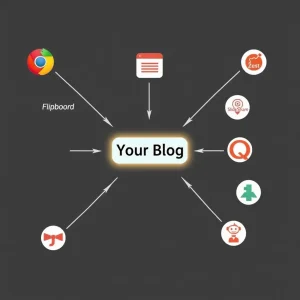You’ve Been Ignoring These Overlooked Traffic Sources
That is a Big Mistake

If you’ve been banging your head trying to get traffic via Google SEO and social media, you might be missing a goldmine. Those channels are great, but there are overlooked traffic sources, hidden traffic channels and unexpected sources of organic traffic, that many newbies ignore (or don’t even know exist). Once you tap into just a couple of these, you’ll likely see growth you didn’t expect. And yes, this is a real piece of the puzzle for Internet Profit Success.
In this post I’ll walk you through seven of those underused traffic sources, how to use them step by step, and some bonus tips to maximize your reach. Let’s jump in.
Why focus on overlooked traffic sources?
Before diving into the list, let’s set the stage. Most people chasing traffic chase what they already know: SEO, social media, maybe email. But competition is fierce there. The cost (in time, energy, algorithm changes) is high.
Hidden traffic channels give you extra leverage. Because fewer people use them, you get lower competition and more chance to stand out.
Plus, combining standard traffic with these “secret” channels can lead to compounding growth, kind of like many small streams flowing into a river. You’ll build multiple traffic rivers that feed your blog or site.
Also, some of these sources are passive or semi‑passive. Once you set them up (upload a SlideShare, get your content eligible for Chrome suggestions), they can keep delivering traffic over time.
Now, let’s dig into the 7 traffic sources most newbies overlook.

1. Google Chrome Suggested Articles (a.k.a. “Articles for You”)
One of the biggest surprising sources of referral traffic is Chrome’s “Suggested Articles” (often labeled “Articles for You” or “Chrome Content Suggestions”). When users open a new tab in Chrome on mobile, they often see recommended articles based on their browsing habits. If your content is relevant, it can appear there.
In fact, Chartbeat data showed that referral traffic from this feature exploded (2,100% growth in one year) and now is among the top sources of referral traffic. It’s become a genuine channel.
How to tap this channel (hidden traffic channel):
Use AMP (Accelerated Mobile Pages) or equivalent mobile‑friendly formats. The Chrome suggestions algorithm often surfaces AMP pages.
Write click‑worthy (but honest) headlines and opening sentences to get users to click.
Create content that resonates broadly (evergreen, useful, emotional).
In Google Analytics, look under Referrals for “googleapis.com / auth‑chrome‑content/suggestion” to spot traffic from Chrome suggestions.
Track it over time and replicate content patterns that succeeded.
Because many people neglect this, you get a “first mover” advantage. If one of your posts gets picked, that can deliver consistent traffic.
2. Flipboard
Flipboard is a content curation app that acts a bit like a digital magazine. People gather articles on themes (topics, interests) and “flip” them into magazines. If your content is good, curators or users may add it to their collections, exposing your work to new eyes.
Many blogs have reported spikes in traffic after being featured on Flipboard magazines.
Steps to use Flipboard:
Format your blog posts with clear headings, visuals, and images (Flipboard is visual).
Submit your best content to relevant Flipboard topics or magazines (either built‑in or curated ones).
Encourage readers or fans to include your post in their magazines.
Monitor referrals from Flipboard (you’ll see flipboard.com or flipboard referrals in analytics).
Test different types of content (how‑to, listicles, visual guides) to see what resonates there.
Flipboard is an often overlooked path to organic traffic because many people think of it just as a reading app, not a distribution channel.
3. Zest.is (for marketers)
Zest.is is a curated content feed specifically for marketing professionals and content creators. It acts like a “new tab” feed that surfaces high-quality, approved content. If your piece is accepted, it gets exposed to a sophisticated audience interested in growth, marketing, and content.
Many marketers undervalue Zest, but it’s exactly the kind of untapped traffic source for beginners in the content/marketing niche.
How to use Zest.is:
Write content that aligns with marketing, online business, content strategies, etc.
Submit your posts to Zest’s community (they review for quality).
Engage with other submissions (comment, upvote) to boost your visibility.
Watch referrals tagged with “zest.is” in your analytics.
Try multiple posts over time; as you build reputation, your acceptance chances grow.
Because the bar is higher, you get more qualified traffic (people already interested in marketing), which helps with conversion, not just raw numbers.

4. SlideShare presentations
Think of SlideShare as “YouTube for slide decks.” Instead of (or in addition to) writing a blog post, convert it into a visually engaging slide deck. Upload it, embed links, and harness SlideShare’s audience and SEO strength.
SlideShare often surfaces in Google results (for keywords, image searches, etc.), giving your slides discoverability.
How to use SlideShare:
Take a blog post or guide and extract the key steps or points into slides.
Use good visuals, minimal text per slide, and a clean design.
Include links (with UTM parameters) back to your blog or landing pages.
Use rich, keyword‑oriented titles and descriptions so SlideShare itself indexes it.
Monitor referrals and leads coming from SlideShare.
One example: someone uploaded a “launch funnel blueprint” deck and got thousands of views and signups via SlideShare.
This is one of those hidden traffic channels where most people think “slides are dead.” But no, people still love formatted, easy‑to-digest slide content.
5. Flickr and visual image platforms
When you hear “Flickr,” you think photos. But image platforms like Flickr, Pinterest, Behance, etc., are also indexable and searchable. If you upload infographics, visuals, designs, or data visualizations with good titles, descriptions, and links, they can drive traffic back to your blog.
This method leverages very visual, often underutilized paths to gain clicks.
How to use Flickr (or similar):
Create useful visuals (infographics, diagrams, custom images) tied to your content.
Upload to Flickr with keyword‑rich file names, titles, captions, tags.
In descriptions or captions, include a link (or embed code) back to your blog.
Make it shareable (allow embedding).
Monitor referrals from “flickr.com” or image platforms in your analytics.
Since many content creators don’t optimize for images or assume images don’t drive much, this becomes an unexpected source of organic traffic if done right.

6. Reddit and niche community forums
This is more hands‑on, but forums and Reddit can be incredibly powerful if you approach it well. The idea: join relevant communities, engage genuinely, and share resources when appropriate. You can’t just drop your link and run, that’s spam. But helpful contributions with insight and occasional links can generate targeted traffic.
How to do it right:
Find 2‑3 niche forums or subreddits where your audience hangs out (for example, /r/entrepreneur, /r/marketing, etc.).
Read their rules (many forbid blatant self‑promotion).
Start by contributing value: answer questions, help others, share insights (without links).
Once you’ve earned goodwill, share a blog post or tool when it’s genuinely helpful.
Use helpful formatting, context, and disclaimers (“just sharing what I wrote, take or leave it”).
Track traffic from referral sources like reddit.com or relevant forum domains.
One marketer answered a “best email tools” question on Quora/Reddit and funneled traffic to their detailed review, getting dozens of visits in one day.
Be consistent. Over time, you’ll get known in communities, and people will even start asking you questions, giving you more opportunities to link and share.
7. Quora Q&A
Quora remains a hidden gem for traffic. Millions search for advice — you answer questions, you help, you subtly (or directly, where allowed) reference your content, and that content can rank on Quora and bring you referral traffic.
How to leverage Quora:
Find 5–10 relevant, high‑traffic questions in your niche (e.g. “best tools for content marketing,” “how to grow blog traffic,” etc.).
Write in-depth, helpful answers (don’t just drop your link).
Where it fits, embed a link to your blog or guide (anchor text or “for more detail, check …”).
Make sure your Quora profile is optimized (with a bio, website link, branding).
Monitor traffic from quora.com referrals.
Over time, your best answers can rank within Quora itself or on search engines, driving steady visits. This is an unexpected source of organic traffic many beginners sleep on.
Bonus tips & strategies to boost all channels
To really maximize these channels, combine them with a few cross-cutting strategies:
1. Repurpose content across formats
Don’t just blog. Turn your posts into slides, visuals, forum snippets, Quora answers, etc. That gives more chances to be seen via different channels.
2. Optimize metadata and SEO
Even in SlideShare, Flickr, Quora, titles, descriptions, tags, keywords matter. Use your main keyword (“overlooked traffic sources”) and related ones.
3. Track everything tightly
Use UTM parameters for links, create segments in your analytics to isolate referrals (e.g. filter for chrome content suggestions, zest.is, flickr, etc.). This tells you what’s working.
4. Double down on what works
If you see traffic from Chrome suggestions, do more content in that style. If Quora answers are performing, answer more.
5. Be patient and consistent
Most of these channels won’t explode overnight. But over weeks/months, as visibility builds, they compound.
6. Blend with “mainstream” channels
Don’t abandon SEO or social media. These hidden sources should augment your traffic, not replace foundational channels.
7. Build content with shareability baked in
Infographics, data visuals, quirky stories, listicles, they tend to get reshared, pinned, flipped, added into magazines, etc. The more shareable, the more likely one of these hidden channels will pick it up.
Sample structure you could use for your own posts
Here’s a pattern you can reuse:
Introduction: Hook + problem + promise (“you’re missing X”)
Section per traffic source (with a mini anecdote or example)
Bonus tips / cross‑channel strategies

CTA (e.g. try 1 or 2 today; monitor results)
Closing encouragement / summary
Mix in your main keyword and related phrases in headings and naturally in the text. For example:
“How Chrome suggestions can become overlooked traffic sources”
“Flipboard: a hidden traffic channel many ignore”
“Use Reddit and forums as unexpected sources of organic traffic”
Also, mention Internet Profit Success in places like: “these hidden traffic sources can be your secret weapon toward Internet Profit Success.”
I have 5 FREE VIDEOS for you to watch to improve your marketing skills
